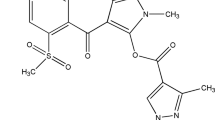Abstract
Piperonyl butoxide (PB) is a known Synergist which enhances the activity of insecticides by inhibiting their biotransformation to less active products. We have evaluated the possible use of PB as a herbicide synergist using triazine herbicides in sensitive, tolerant, and resistant plants. The effects of PB, triazine herbicides, and their combinations were examined in whole plants as well as in chloroplasts isolated from triazine-sensitive (S) and -resistant (R) weed biotypes. PB itself, applied postemergence (0.1–0.5%, v/v), was slightly toxic to the plants tested. However, foliar application of PB combined with atrazine, terbutryn or prometryn to maize seedlings significantly increased the phytotoxicity of the herbicides. Low rates of atrazine, prometryn, and terbutryn in a tank-mixture with PB, effectively controlled Solatium nigrum L. and Abutilon theophrasli Medik. PB enhanced atrazine efficacy in both S and R biotypes of Lolium rigidum Gaud. The synergistic effect of PB was evident also in vitro when atrazine and methabenzthiazuron were used to inhibit photosystem II electron transport in chloroplasts isolated from resistant weeds. These data demonstrate the potential of PB as a herbicide synergist and its possible utilization as an aid for improving the activity of triazine herbicides in sensitive, tolerant and resistant plants.
Similar content being viewed by others
References
Barta, C. and Dutka, F. (1991) Influence of 1-aminobenzotriazole (ABT) derivatives on the toxicity of EPTC to monocotyledonous plants.Weed Res. 31:89–95.
Boydston, R.B. and Slife, F.W. (1986) Alteration of atrazine uptake and metabolism by tridiphane in giant foxtail(Setaria faberi) and corn(Zea mays).Weed Sci. 34:850–858.
Chang, F.Y., Smith, L.W. and Stephenson, G.R. (1971) Insecticide inhibition of herbicide metabolism in leaf tissues.J. Agric. Food Chem. 19: 1183–1186.
Devlin, R.M. (1973) Influence of phenoxy growth regulators on the uptake of naptalam byPotamogeton pectinatus.Proc. Northeast Weed Sci. Soc. 27: 115–119.
Dudek, C.E., Basler, E. and Santelmann, P. W. (1973) Absorption and translocation of terbutryn and propazine.Weed Sci. 21:240–443.
Fedtke, C. (1987) Physiological activity spectra of existing graminicides and the new herbicide 2-(2-benzothiazol-oxy)-N-methyl-N-phenylacetamide (mefenacet).Weed Res. 27:221–228.
Franklin, M.R. (1977) Inhibition of mixed-function oxidations by substrates forming reduced cytochrome P-450 metabolic-intermediate complexes.Pharmacol. & Ther. Part A 2:227–245.
Gaillardon, P., Cabanne, F., Scalla, R. and Durst, F. (1985) Effect of mixed function oxidase inhibitors on the toxicity of chlorotoluron and isoproturon to wheat.Weed Res. 25:97–102.
Hatzios, K.K. (1983) Interactions of the herbicides EPTC and EPTC plus R-25788 with ozone and antioxidants in corn.J. Agric. Food Chem. 31: 1187–1191.
Hatzios, K.K. (1983) Effects of CGA-43089 on the responses of sorghum(Sorghum bicolor) to metolachlor combined with ozone or antioxidants.Weed Sci. 31:280–284.
Hatzios, K.K. and Penner, D. (1985) Interaction of herbicides with other agrochemicals in higher plants.Rev. Weed Sci. 1:1–63.
Hodgson, E. (1985) Microsomal mono-oxygenases.in: Kerkut, G.A. and Gilbert, L.I. [Eds.] Comprehensive Insect Physiology, Biochemistry and Pharmacology, pp. 225–321. Pergamon Press, Oxford.
Jones, D.W. and Foy, C.L. (1972) Tracer studies with14C labeled herbicides, DMSO and surfactant.Weed Sci. 20:81–85.
Kemp, M.S., Newton, L.V. and Caseley, J.C. (1988) Synergistic effects of some P-450 oxidase inhibitors on the phytotoxicity of chlorotoluron in resistant population of black-grass(Alopecurus myosuroides).Proc. European Weed Research Society Symp. (Wageningen, the Netherlands), pp. 121–126.
Lamoureux, G.L. and Rusness, D.G. (1986) Tridiphane [2-(3,5-dichlorophenyl)-2-(2,2,2-trichloroethyl)oxirane] an atrazine synergist: Enzymatic conversion to potent glutathione-S-transferase inhibitor.Pestic. Biochem. Physiol. 26:323–342.
Putman, A.R. and Penner, D. (1974) Pesticide interactions on higher plants.Residue Rev. 50:73–110.
Rubin, B., Adler, U., Varsano, R. and Rabinowitch, H.D. (1986) Effect of ethofumesate on the epicuticular waxes of onion leaves, and on the response of plants to foliar-applied herbicides.Ann. Appl. Biol. 108: 365–371.
Rubin, B. and Eshel, Y. (1977) Absorption and translocation of terbutryn and fluometuron on cotton(Gossypium hirsutum) and snap beans(Phaseolus vulgaris).Weed Sci. 25:499–505.
Rubin, B., Leavitt, J.R.C., Penner, D. and Saettler, A.W. (1980) Interaction of antioxidants with ozone and herbicide stress.Bull. Environ. Contain. Toxicol. 25:623–629.
Rubin, B., Yaacoby, T. and Schonfeld, M. (1985) Triazine resistant grass weed: cross resistance with wheat herbicide, a possible threat to cereal crops.British Crop Protection Conf.-Weeds 3:1171–1178.
Shimabukuro, R.H. (1985) Detoxication of herbicides,in: Duke, S.O. [Ed.] Weed Physiology: Herbicide Physiology. Vol. II, pp. 215–240. CRC Press Inc., Boca Raton, FL.
Stolp, C.F. and Penner, D. (1973) Enhanced phytotoxicity of atrazine-phosphate combinations.Weed Sci. 21:37–40.
Testa, B. and Jenner, P. (1981) Inhibitors of cytochrome P-450s and their mechanism of action.Drug Metabol. Rev. 12:1–117.
Varsano, R. and Rubin, B. (1988) Synergistic effect of piperonyl butoxide with triazine herbicides in plants.Proc. European Weed Research Society Symp. (Wageningen, the Netherlands), pp. 127–132.
Yaacoby, T., Schonfeld, M. and Rubin, B. (1986) Characteristics of atrazine-resistant biotypes of three grass weeds.Weed Sci. 34:181–184.
Author information
Authors and Affiliations
Rights and permissions
About this article
Cite this article
Varsano, R., Rubin, B. Increased herbicidal activity of triazine herbicides by piperonyl butoxide. Phytoparasitica 19, 225–236 (1991). https://doi.org/10.1007/BF02981120
Received:
Revised:
Issue Date:
DOI: https://doi.org/10.1007/BF02981120




